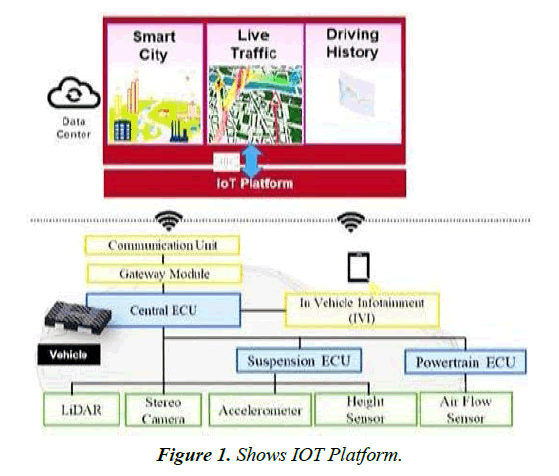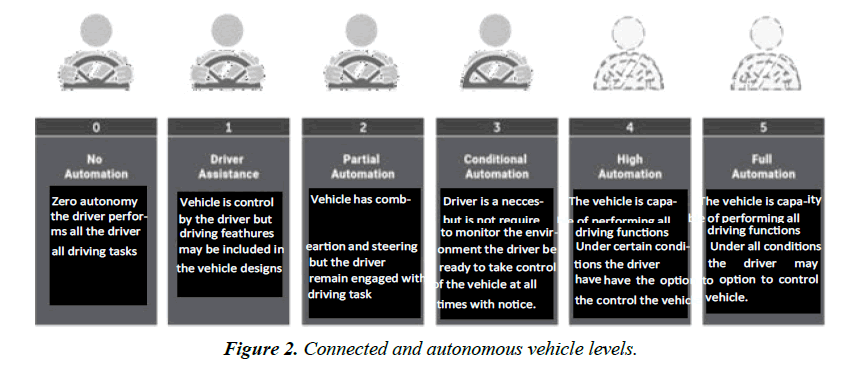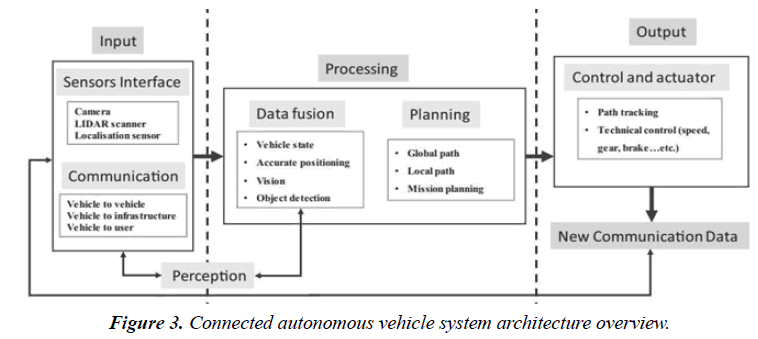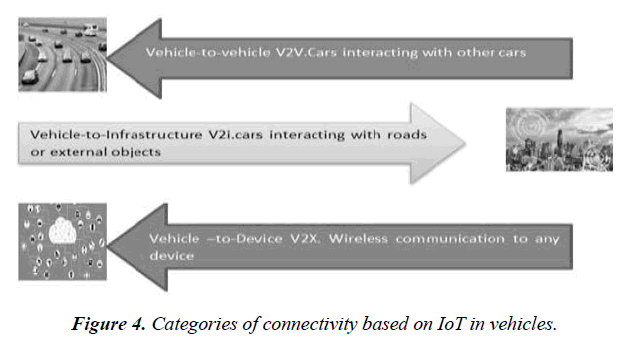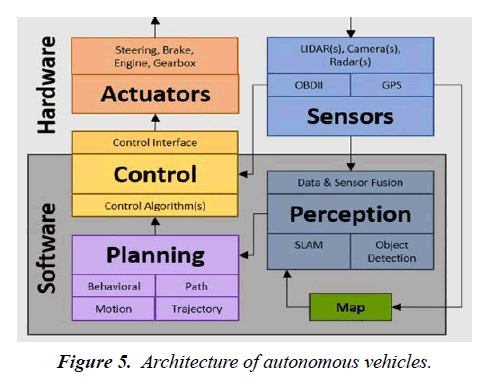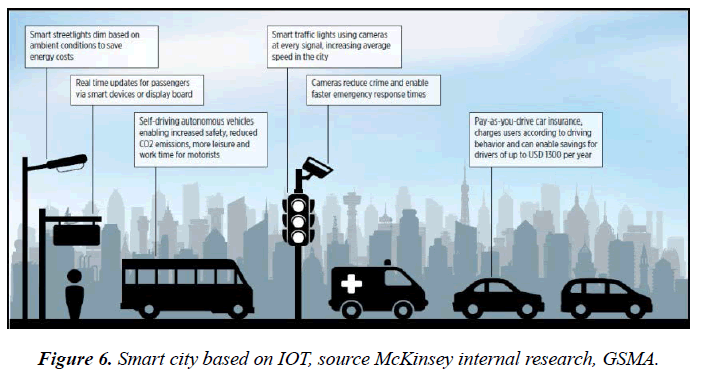Review Article - Materials Science and Nanotechnology (2022) Volume 6, Issue 6
Deployment of connected and autonomous vehicles by transforming next decade reducing based on IoT.
Febronie Nambajemariya1*, Niyigena Kwizera2, Vincent D Paul1, Twizerane Jean d’amour21Department of Electronics and Information engineering, Lanzhou Jiaotong University, Lanzhou, China
2Department of Mechatronics Engineering, Lanzhou Jiaotong University, Lanzhou, China
- *Corresponding Author:
- Febronie Nambajemariya
Department of Electronics and Information engineering
Lanzhou Jiaotong University, Lanzhou, China
E-mail: febroniemariya@gmail.com
Received: 28-Oct-2022, Manuscript No.AAMSN-22-25731; Editor assigned: 31-Oct-2022, PreQC No.AAMSN-22-25731 (PQ); Reviewed: 12-Nov-2022, QC No.AAMSN-22-25731; Revised: 19-Nov-2022, Manuscript No.AAMSN-22-25731 (R); Published: 25-Nov-2022, DOI: 10.35841/aamsn-6.6.127
Citation: Nambajemariya F, Kwizera N, D Paul V, et al. Deployment of connected and autonomous vehicles by transforming next decade reducing based on IoT. Mater Sci Nanotechnol. 2022;6(6):127
Abstract
Connected and Autonomous Vehicles (CAVs) will have a huge effect on our cities and regions in the next ten years, and society will experience profound improvement in the methods of transportation. As fast mobile Internet access is becoming increasingly popular and countless wireless networking technologies are being adopted on the market, new opportunities continue to arise for goods and services, allowing interconnection and Autonomous Vehicles (CAV). CAV can connect and communicate with the surrounding world digitally with the help of the Internet of Things. This involves not only connections to other vehicles (car-to-car), but also infrastructure connections (car-to-infrastructure) and other devices (car-to-device). This functionality therefore gives way to a new range of technologies, such as enhanced safety features, customized experiences for driving and entertainment, and even autonomous driving.
Keywords
IoT, Connected cars, Autonomous car, Autonomous driving.
Introduction
The Internet of Things (IoT) is a new wave of Internet that is expected to transform our lives. Internet has connected people and now it is connecting. Things‘to make seamless communication and intelligence pooling. IoT is a disruptive technology that has tremendous potential to change the world and is changing the way we live. The development and uptake of connected cars solutions in the coming years is driven by an increase in embedded connectivity in cars [1]. In addition, current megatrends on connected devices, energy efficiency, security, and health further drive growth in the segment. Besides this, the uptake can benefit from the realignment of short term milestones with a clear long term vision, from continuous innovation efforts, from the cooperation between different types of actors coming from different industries, and from large scale investments in infrastructure.
Literature Review
Internet of things
The Internet of Things (IoT) is defined as a paradigm in which objects equipped with sensors, actuators, and processors communicate with each other to serve a meaningful purpose. More than 85% of systems are unconnected and do not share data with each other or the cloud. One such technology that facilitates the interconnection is the internet of the things. In the IoT also means making devices smarter, by connecting them online to acquire and process data [2]. Today IoT has touched every corner of the world. Internet of Things is simply an interaction between the physical and digital worlds. The digital world interacts with the physical world using a plethora of sensors and actuators. IoT devices are equipped with sensors, actuators and processors. Figure 1 show us the main platform of IoT, Sensors are used for interacting with the physical environment. The data collected by the sensors have to be stored and processed by the processor [3]. The actuator performs. The desired action depending on the value from the sensor. The storage and processing of data can be performed at that remote server. The pre-processing of data can be done at the sensor level. The communication between the IoT devices is wireless. Sensors, actuators, compute servers, and the communication network forms the core infrastructure of an IoT framework [4]. (Figure 1).
Background on IoT components in connected and autonomous vehicles
The European automotive industry, representing 6.1% of total EU employment and 7% of EU GDP, is facing a digital revolution in the 21st century in the form of the connected and autonomous vehicle (vehicle to everything-which includes vehicle-to-vehicle, vehicle-to-infrastructure, v e h i c l e - t o - network, vehicle-to-cloud, vehicle-to-device and vehicle-topedestrian). With the integration of Internet of Things (IoT) components into vehicles, they become part of a network [5]. Vehicles can communicate with each other, with the surrounding infrastructure and with other drivers. Gradually the technologies of IoT for connected and autonomous vehicles (combined with the evolution of Artificial Intelligence and communication networks) support assisted driving (steering, acceleration and brake support), then conditional automation(the system has longitudinal and lateral control in a specific use case), followed by high automation (the system can cope with all situations automatically in a defined use case) and finally full automation (the system is able to drive the vehicle in all conditions; no driver is required) [6,7]. The autonomous driving is grouped into six different levels by the international Society of Automotive Engineers (SAE) according to the amount of driver intervention and attentiveness required (Figure 2). The human driver does all the driving (Table 1).
| No | System | Performance parameters | Processing techniques | Applications | |
|---|---|---|---|---|---|
| 1 | Car parking system | Infrared Ray Sensor, Mobile application, RFID, payment through bank. | Internet of Things | Smart City | |
| 2 | Managing Traffic congestion system | Irsensors, RFID‘s, Zigbee, Traffic warning systems, bigdata, Bluetooth, microcontroller, actuator | Internet of things | Traffic congestion | |
| 3 | Intelligent System | Transportation | WSN and IOT | Low cost system | Road Traffic |
| 4 | Infotainment system | Radios and cassette or CD players, and automotive navigation systems, video players, USB and Bluetooth | Iot | Entertainment | |
| 5 | Cloud computing system | Software as a Service (saas), Platform as a Service (paas), and Infrastructure as a Service (iaas). | |||
| 6 | Intelligent system | Transportation | Iot | Iot | Traffic congestion |
| 7 | Vehicle identification | Sensor, actuator, Media Access Control (MAC) addresses via Bluetooth or Wi-Fi. | Road side transportation based Internet of Things (IOT) | Road Traffic | |
| 8 | Vehicle monitoring | Gps, gsm | Superior exercise of contemporary technology | Road Traffic | |
| 9 | Automated traffic system | Smart safety and street safety plans | Internet of Things (iot) | Traffic congestion | |
Table 1. Technology and performance parameters used in automotive industry using IoT.
An Advanced Driver Assistance System (ADAS) on the vehicle can sometimes assist the human driver with either steering or braking/accelerating, but not both simultaneously [8]. An advanced driver assistance system (ADAS) on the vehicle can itself actually control both steering and braking/ accelerating simultaneously under some circumstances. The human driver must continue to pay full attention (-monitor the driving environment) at all times and perform the rest of the driving task [9,10]. An Automated Driving System (ADS) on the vehicle can itself perform all aspects of the driving task under some circumstances. In those circumstances, the human driver must be ready to take back control at any time when the ADS request the human driver to do so. In all other circumstances, the human driver performs the driving task (Figure 3). An Automated Driving System (ADS) on the vehicle can itself perform all driving tasks and monitor the driving environment essentially, do all the driving-in certain circumstances. The human need not pay attention in those circumstances [11,12]. An Automated Driving System (ADS) on the vehicle can do all the driving in all circumstances. The human occupants are just passengers and need never be involved in driving (Figure 3).
Why IoT in connected and autonomous vehicles
Connected and autonomous vehicles are a combination of Internet-of-Things (IoT) devices and networking capability to communicate with the surrounding physical and digital environment. Depending on the supported features, a connected vehicle may be able to communicate with the following [13].
Vehicle occupants, occupants of other vehicles, connected devices, e.g., mobile phones; pedestrians.
Internet-based applications.
Security Credential Management System (SCMS), a message security solution for vehicle-to- vehicle (V2V) and vehicletoinfrastructure (V2I) communication.
Surrounding transportation physical infrastructure (this could include traffic signal controller, roadway infrastructure, traffic management centers-both local computing and cloud platforms) (Figure 4).
The Internet of Things (IoT) refers to the connectivity of multiple devices through the Internet. Driverless cars utilize this connectivity when updating their algorithms based on user data. These autonomous vehicles require an enormous quantity of data collecting and processing. In this case, through IoT, the driverless car shares information about the road (which has already been mapped out). This information includes the actual path, traffic, and how to navigate around any obstacles. All of this data is shared between IoT connected cars and is uploaded wirelessly to a cloud system to be analyzed and put to use improving the automation [14].
The connected cars have multiple communication possibilities to connect to other vehicles (Vehicle-to-Vehicle) or exchange information with the external environments (Vehicle-to-road infrastructure), networks and services (Vehicle to Internet). These interactions provide a promising opportunity to address the increasing transportation issues, such as heavy traffic, congestion, and vehicle safety as figure 1 explain [15].
Ways IoT is transforming automotive industry
The Internet of Things (IoT) is rapidly changing how we live. The Internet of Things finds various applications in healthcare, fitness, education, entertainment, social life, energy conservation, environmental monitoring, home automation, and transport systems. This is particularly true of the automobile industry, which is where some of the biggest innovations are being developed and implemented, With the emergence of IoT and Big Data economy, the players of automotive industry need to transform themselves in order to catch up with the new economy era. So with that in mind, here are some of the biggest ways the IoT is transforming the automotive industry and our roads [16].
The way people drive
✓ Improving road safety.
✓ Solve traffic congestion in cities.
✓ Reduce pollution and energy expenditure.
✓ Lead to better roads.
✓ Environment applications.
✓ Mobility applications.
Some technology and performance parameters used in automotive industry using iot
Autonomous vehicle
A definition of a self-driving vehicle is any vehicle with features that allow it to accelerate, brake, and steer with limited or no driver interaction. Depending on who defines how and where the definition comes from, autonomous vehicles are divided into two different types
• Semi-autonomous and
• Fully autonomous
Semi-autonomous cars can accelerate, brake and steer, keep the distance from the car in front and also keep the lane at speeds up to 130 km/h, but the driver is still required and is still in full control. A fully autonomous vehicle can drive from point A to point B without needing any interaction from the driver. It is expected and believed that this type of car will debut in 2019/ 2020 timeframe. Below we have an example of autonomous car [17].
Discussion
Connected and automated vechicles on roads and intersections
Technological advancements seen every day in areas like information technology, communication, and data analysis and storage etc.is not exclusive to these areas alone. The realm of autonomous cars is also progressing at a rapid rate these days. The economic effect of the use of autonomous (a word most people currently use in place of connected and automated vehicles) transportation is provided by reducing the time and cost of transporting goods and passengers and more efficient use of roadway capacity. Reducing fuel consumption will lead to a decrease in the emissions of harmful substances into the atmosphere, which will positively affect the environment to reduce the greenhouse effect. Autonomous. Transportation management will increase the comfort of passengers expanding the use of vehicles for people with disabilities(Figures 5 and 6).
Conclusion
Effects and applications of internet of things in connected and autonomous vehicles
From a societal perspective, connected cars can help increase safety, productivity, and energy efficiency. An autonomous car can operate without human control and does not require any human intervention. Stated that modern autonomous vehicles can sense their local environment, classify different kinds of objects that they detect, can interpret sensory information to identify appropriate navigation paths whilst obeying transportation rules. Advanced safety features help drivers anticipate dangers and can even prevent collisions. Moreover, with access to information on current traffic conditions on the road, connected cars can dynamically optimize routes, limiting traffic congestions and freeing up time to do other things. In cities, the development of smart grids, data analytics and autonomous vehicles will provide an intelligent platform to deliver innovations in energy management, traffic management and security, sharing the benefits of this technology throughout society. Below figure describes the examples of IoT smart cities applications.
References
- George Gemini, Sabu M Thampi. Vulnerability-based risk assessment and mitigation strategies for edge devices in the Internet of Things. Pervasive Mob Comput. 2019;59:101068.
- Lawal K, Rafsanjani HN. Trends, benefits, risks, and challenges of IoT implementation in residential and commercial buildings. Energy Build. 2021.
- Menon VG, Jacob S, Joseph S, et al. An IoT-enabled intelligent automobile system for smart cities. Internet Things. 2020;3:100213.
- Jat, Dharm Singh, Anton S Limbo. et al. Speech-based automation system for the patient in orthopedic trauma ward. Smart Biosensors in Medical Care. Academic Press. 2020; 201-14.
- Hidalgo Carlos. Detection control and mitigation system for secure vehicular communication. Veh Commun. 2022;100425.
- Lu Q, Tettamanti T, Hörcher D, et al. The impact of autonomous vehicles on urban traffic network capacity: an experimental analysis by microscopic traffic simulation. Transportation Letters. 2020;12(8):540-9.
- Choi DK, Jung JH, Kim JI, et al. IoT-Based Resource Control for In-Vehicle Infotainment Services: Design and Experimentation. Sens. 2019;19(3):620.
- Jadaan K, Zeater S, Abukhalil Y. Connected vehicles: An innovative transport technology. Procedia Eng. 2017;187:641-648.
- Aris IB, Sahbusdin RK, Amin AF. Impacts of IoT and big data to automotive industry. In2015 10th Asian control conference (ASCC) 2015 (pp. 1-5). IEEE.
- Mendiratta S, Dey D, Sona DR. Automatic car parking system with visual indicator along with IoT. In 2017 International conference on microelectronic devices, circuits and systems. 2017;10:1-3.
- Kundra A, Maheshwari A. Design of Intelligent Traffic Management Systems using Computer Vision and Internet of Things. Int j comput sci inf technol res. 2016;6(1):11-18.
- Saleem M, Abbas S, Ghazal TM, et al. Smart cities: Fusion-based intelligent traffic congestion control system for vehicular networks using machine learning techniques. Egypt. Inform. J. 2022.
- Fahmideh M, Zowghi D. An exploration of IoT platform development. Inf Syst. 2020; 87:101409.
- Seif HG, Hu X. Autonomous driving in the iCity—HD maps as a key challenge of the automotive industry. Eng. 2016;2(2):159-62.
- Bimbraw K. Autonomous cars: Past, present and future a review of the developments in the last century, the present scenario and the expected future of autonomous vehicle technology. In 2015 12th Control Autom Robot. (ICINCO) 2015;1:191-198.
- Ko E, Kim SH, Kim M, et al. Organizational characteristics and the CRM adoption process. J Bus Res. 2008;6(1):65-74.
- Atzori L, Iera A, Morabito G. Understanding the Internet ofThings: definition potentials and societal role of a fast evolving paradigm. Ad Hoc Netw. 2017;56:122-140.
Indexed at, Google Scholar, Cross Ref
Indexed at, Google Scholar, Cross Ref
Indexed at, Google Scholar, Cross Ref
Indexed at, Google Scholar, Cross Ref
Indexed at, Google Scholar, Cross Ref
Indexed at, Google Scholar, Cross Ref
Indexed at, Google Scholar, Cross Ref
Indexed at, Google Scholar, Cross Ref
Indexed at, Google Scholar, Cross Ref
Indexed at, Google Scholar, Cross Ref
Indexed at, Google Scholar, Cross Ref
Indexed at, Google Scholar, Cross Ref
